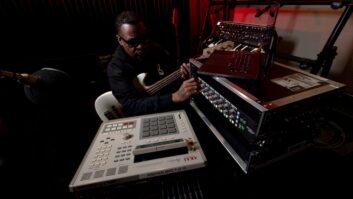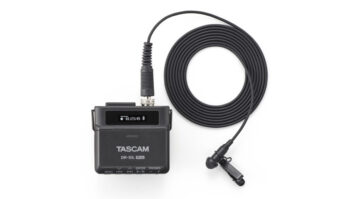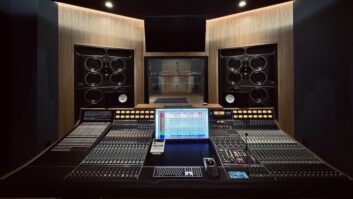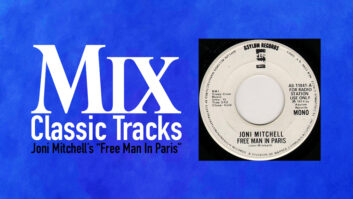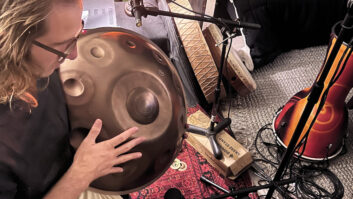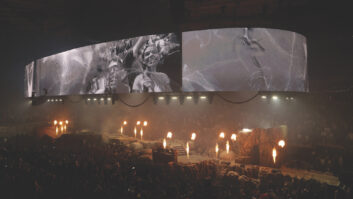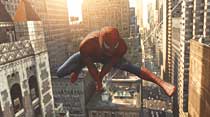
Photo: Sony Pictures Imageworks
When we last left Spider-Man, the web-slinger had finally triumphed over the nefarious Green Goblin, while his infatuation with lovely Mary Jane Watson had more than his Spidey Sense tingling. Now, two years later, Watson is headed toward the altar with some other lunk-head and (surprise!) there’s a creepy new villain in town: Dr. Otto Octavius, better known as the steel-tentacled Dr. Octopus — or you can just call him “Doc Ock”; everyone does.
“This film was mixed in true comic book fashion, with plenty of wham, bam and pow!” enthuses effects re-recording mixer Greg Russell during a break from the final mix of Spider-Man 2 at the Cary Grant Theatre on the Sony lot in L.A. Russell and his partner, dialog and music mixer Kevin O’Connell, were also onboard for Spider-Man in 2002, earning an Oscar nomination for their work on the film. Both note that director Sam Raimi has an intense interest and involvement with the sound for his films.
L-R: Paul Ottosson, Kevin O’Connell, Greg Russell, Jeff Haboush
“Nobody dissects a soundtrack like Sam Raimi,” O’Connell says. “We’ll go into [mixing] an action scene and he’ll say, ‘Okay, take everything out. Take all the air out, take all the backgrounds out, the traffic, the wind, everything. Now I want you to put in Spidey’s web sounds and then put in that chin sock. Now I want you to put in Doc Ock’s feet and hands and whatever.’ He likes to build from scratch rather than going the other way, where we have everything in there and then try to figure out what’s not working.”
Though Spider-Man 2 naturally shares some sonic similarities with its predecessor, it also presented plenty of new sound opportunities, from the complexity of the Doc Ock character to rethinking the noise of Spider-Man’s webs. On the recommendation of film editor Bob Murawski, Raimi hired a new supervising sound editor/sound designer for this show: Paul Ottosson, who has had limited supervisorial experience, but quickly showed himself to be both creative and adaptable to Raimi’s work methods.
“Paul really stepped up to the plate and delivered some amazing sounds,” O’Connell says. “Over the course of 140 films or so, I’ve heard it all, but this guy came up with some stuff I’ve never heard before. That’s really exciting to a mixer.”
“One of the first things Sam said was that he wanted the sound of the spider web to be a little more organic,” Ottosson says. “So I went to one of the biggest stages they have here on the lot — it’s about 300 feet long — and I rigged it up with microphones and I went in with a sling shot and started shooting all these objects past the microphones. I shot everything from pieces of copper piping to coins, hoping to get some sounds that would work for the trail of the web as it goes through the air.” Ottosson recorded these effects using matched-pair arrays of Oktava microphones and a Deva 4-track. “The Oktavas sounded great and they’re not expensive, which was good because I kept hitting them,” he says with a laugh.
Not surprisingly, Doc Ock proved to be one of Ottosson’s greatest challenges. “I saw him as a man first, so I didn’t want it to be just machine noise,” he explains. “I wanted the tentacles to sound more alive, like he is, because they really do have their own personality. So I got the heaviest grade of motorcycle chains that I could find and washed them in acid to get some more metallicness out of them. Since each link in the chain is perfect in shape and size, it gave the tentacles more fluidity. Then we would throw the chains or roll them in different ways and it would have a particular rhythm. I also wanted the sounds of the tentacles retracting. Again, I didn’t want it to just be a machine sound, like a servo, so I ended up using really heavy-gauge piano strings. I would pull them across different objects — other strings or metallic objects. We used that almost like a motor, but it doesn’t sound like a regular motor.”
Ottosson built his effects tracks in Pro Tools, manipulated them with various plug-ins and delivered hundreds of possibilities for the full range of Doc Ock’s motions to Russell. “There’s a lot of nuance to Doc Ock’s sounds,” the mixer says. “There’s his footsteps, which I separated into LCR and LCR surround. Then I had his tentacle predub, which comprises sort of ratchety, spinal kind of metallic sounds and a wire motion, which also has whooshing effects that go with it. Then there’s the claws predub — he has big claws and little claws within the big claws, which have microscopic sounds of what’s inherent in the larger claws. And then there are vocals for those claws — they talk to him, they communicate with him with sort of high-end screechy vocalizations — and those are separated.
“I probably had about 100 tracks for the tentacles,” Ottosson continues, “but we had them on different stems. All the elements for the left tentacle would be on maybe four tracks, and all the elements for the right one on four, and the lower and upper ones would be on four tracks and then each claw would be another two or three tracks each. The vocalizations of the claws would be more — it was huge. Then Sam would like everything except for that one claw way over there to the right,” he says, chuckling. “But because we had the stems, we were able to go in and fix things pretty easily.”
Russell and O’Connell mixed on the huge Harrison MPC digital console on the Carey Grant stage, and as Russell notes, “Working in surround really gives me the latitude to play. There’s a ton of surround work in this movie: a lot of movement, a lot of panning. With Doc Ock, you have his tentacles and his feet and all this motion in every direction — he was made for surround. He winds up these tentacles and I just drive these low whooshes and thick metal sounds through the surrounds and up to the front and back to the back.”
“A couple of times, we go to the perspective of one of Doc Ock’s tentacles,” O’Connell says, “and maybe the tentacle perceives things in the surrounds that we don’t. So we’ve done some of that. I used the surrounds a lot in the music to add some depth. I’ll have some ambient orchestra in there. Occasionally, I’ll put some percussion things out there for effect, too.”
As always, the final mix requires an intricate dance between score (composed by Danny Elfman and mixed by Dennis Sands), dialog and effects. “One of the cool things about Sam,” O’Connell proffers, “is that unlike a lot of directors, he’s not afraid to just let the effects tell the story sometimes, so there are scenes where Danny Elfman lays out and we tell the story with sound effects versus having it be a train wreck where they’re both playing at the same time. That goes the other way, too. The effects get scaled back to let the music be heard. We’ve developed a way to look at a scene, decide who’s telling the story and the emotion better — the music or the sound effects — and then make a choice. One of them might go away completely or play subliminally to the other one. Sam usually has an idea of what he wants, and I must say, having worked on two of these films with him, he’s usually right.”


